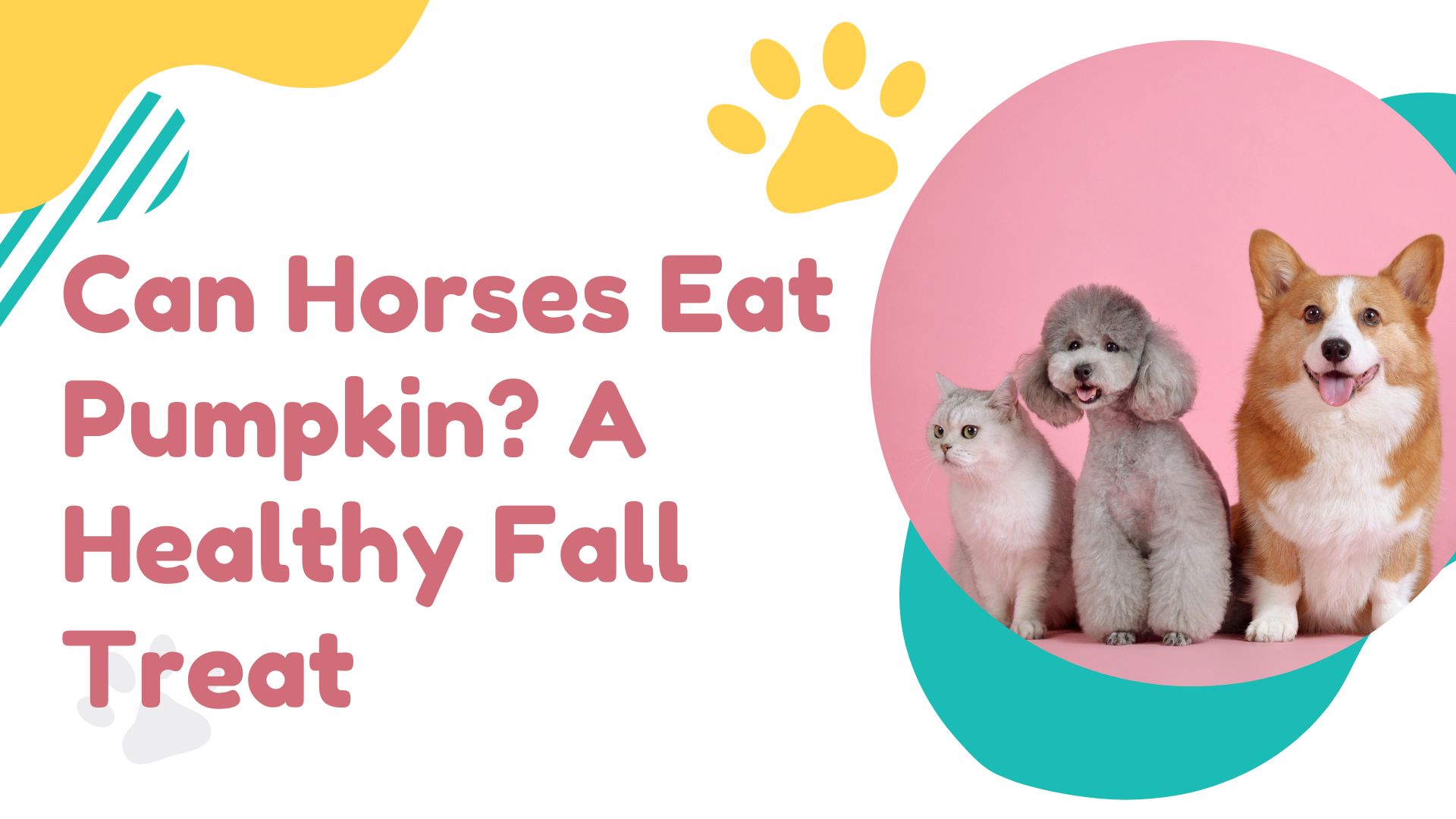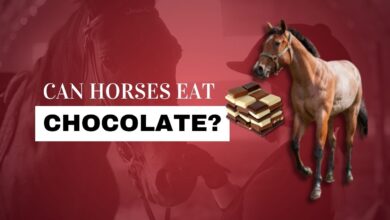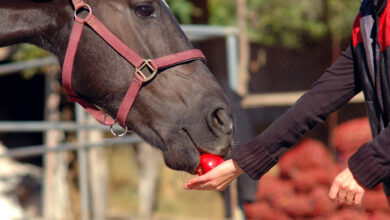
As autumn arrives, horse owners decorate their barns and pastures with festive gourds and pumpkins.
But did you know that pumpkins aren’t just for decoration?
That is where the REAL question arrives… can horses eat pumpkin?
These seasonal fruits can also be a nutritious treat for your horse. Let’s look at the benefits and risks of adding pumpkins to your horse’s diet.
Can Horses Eat Pumpkin? The Benefits and Risks of Pumpkin
A horse’s gastrointestinal tract is designed to digest high-fiber feeds. Their diet should consist mainly of roughage like hay and grass.
But there’s room for supplemental treats as well. In fact, treats like pumpkins can provide important vitamins, minerals, and variety.

But it’s key to choose and prepare treats carefully, as horses have very sensitive digestive systems.
What do the Experts Say?
According to equine nutrition guides like Kerr Equine, pumpkins are packed with nutrients. The bright orange flesh is high in vitamin A, providing over 100% of a horse’s daily needs in just one cup!
Pumpkins also contain vitamin C, vitamin E, potassium, and iron. And with a 90-95% water content, pumpkins are a hydrating, low-calorie snack.
The high fiber in pumpkins supports healthy digestion. The beta-carotene in vitamin A helps maintain a healthy immune system and supports skin and hoof health as seasons change.
And minerals like potassium are essential for nerve function, while iron carries oxygen throughout the body.
But don’t go pumpkin overload! Too much vitamin A can cause toxicity. And the seeds and stems can present a choking hazard if swallowed. We’ll cover proper serving guidelines coming up.
To get an expert opinion, I spoke with equine nutritionist Dr. Sarah Gold of Equine Wellness Inc. She said:
“Pumpkins are a great occasional treat for horses when fed properly. The vitamins and minerals can complement their regular diet. Just be sure to start slowly with small amounts to see how your horse tolerates it.”
Read More: Can Horses Eat Watermelon?
Key Nutritional Components
When considering pumpkins for your horse, think about their key nutritional components:
- Water Content – Pumpkins are 90-95% water, providing hydration.
- Vitamin A – One cup of pumpkin contains over 100% of a horse’s vitamin A needs. Supports vision, skin, hooves, and immunity. But too much can cause toxicity.
- Vitamin C – Supports collagen production, immunity, antioxidant health.
- Vitamin E – An important antioxidant that protects cells from damage.
- Potassium – Essential for nerve and muscle function.
- Fiber – Pumpkins provide both soluble and insoluble fiber to support digestion.
- Low Calories – A good choice for horses needing to lose weight. Far lower in calories than treats like apples.
- Iron – Carries oxygen through the bloodstream. Prevents anemia.
- Zinc – Important for many enzymes and supports wound healing.
- Beta-Carotene – An antioxidant that converts to vitamin A in the body. Also gives pumpkins their orange color!
Some other nutrients found in lower amounts include magnesium, phosphorus, copper, manganese, vitamin B6, niacin, and folate. It’s an impressive nutritional profile!
The seeds and stems of pumpkins can present a choking risk, so they should always be removed before feeding.
The outer rind is also very tough and difficult to digest.
Always scoop out the flesh.
Some types of pumpkins like sugar/pie pumpkins have a higher carbohydrate content. Opt for standard orange field pumpkins when possible. Or choose supplement treats made with pumpkin.
So while pumpkins make a festive barn or pasture decoration, your horse can enjoy them as a treat too. In moderation, pumpkin flesh can provide valuable nutrients.
Just be sure to start slowly and feed properly prepared portions.
Feeding Pumpkins to Horses: A Healthy Fall Treat
Now that we’ve covered the nutritional benefits of pumpkins, let’s look at some potential downsides and how to feed pumpkins safely.
While too many treats can cause obesity and other issues, pumpkins in moderation can be a healthy part of your horse’s diet.
The biggest risk of overfeeding pumpkins is toxicity from too much vitamin A. As little as 2-3 pounds of pumpkin per day could surpass the toxicity level for a 1000 lb horse.
Symptoms include lack of coordination, lethargy, and bone swelling. Always feed pumpkin as a limited treat.
The natural sugar content could also cause digestive upset if fed in large amounts. Stick to a handful of flesh at a time – no more than 2 cups.
Signs of colic or diarrhea mean stop feeding immediately.
As we touched on earlier, the tough outer rind, seeds, and stems should always be removed as they can pose a choking hazard.
Even large pieces of flesh should be chopped or mashed to reduce this risk.
Expert Advice
To get expert advice on safe pumpkin preparation, I interviewed Samantha Jones, equine care specialist from Tractor Supply Co. She recommends:
“Slice pumpkin flesh into bite-size chunks rather than feeding a whole wedge. Remove all seeds and fibrous pulp. Mash or puree to make it easier to digest. This lower risk of choke is worth the extra effort!”
Use the following tips to safely incorporate pumpkin into your horse’s diet:
- Start with a small portion like 1⁄4-1⁄2 cup to see if any digestive upset occurs.
- Gradually work up to 1-2 cups max per day for a 1000 lb horse.
- Feed pumpkin flesh only – no seeds, stems, or rind.
- Chop flesh into bite-size pieces or mash/puree.
- Add a few tablespoons to feed to increase palatability.
- Mix with apple sauce or carrots for moisture and binding.
- Store any leftover pumpkin in the refrigerator for up to one week.
Try incorporating pumpkin into your horse’s meals 2-3 times per week during autumn for variety. For convenience, you can make homemade pumpkin treats. Some recipes to try include:
- Pumpkin Horse Cookies – Mix pumpkin puree, oats, molasses, and baking powder then bake into crunchy cookies.
- Pumpkin Applesauce – Blend pumpkin flesh with applesauce and cinnamon.
- Pumpkin Carrot Mash – A moist blend of cooked pumpkin and carrots.
- Pumpkin Muffins – Whip up a batch of pumpkin-packed muffins with bananas or applesauce.
While pumpkins can be a fun and healthy seasonal snack, always exercise caution when introducing new foods. Stop feeding if any signs of distress occur and consult your vet with any concerns.
With proper preparation and moderation, pumpkin flesh can provide vitamins, minerals, fiber, and antioxidants. Give your horse a taste of fall with nutritious pumpkin treats!
Feeding Pumpkins to Horses: A Healthy Fall Treat
While pumpkins make a nutritious occasional treat for most horses, it’s important to monitor your horse’s reaction.
Stop feeding pumpkins immediately if any signs of distress occur and notify your vet. Let’s cover what to watch for.
A Brief Overview on Choke
Choke is one of the biggest risks when feeding large, hard pieces of pumpkin flesh. Choke occurs when chunks become lodged in the esophagus, blocking the airway.
Symptoms include coughing, uneasiness, stretched neck, and discharge from the nostrils.
This is a medical emergency requiring prompt veterinary care.
To help prevent choke, always chop pumpkin flesh into small pieces before feeding. Mash or puree it for horses that bolt down food. And avoid rinds, seeds, and stems entirely.
Colic is another potential issue to watch for. Excessive gas, abdominal pain, rolling, inability to pass manure, or lack of appetite could indicate colic. Stop feeding pumpkins and call your vet right away if colic symptoms arise.
According to veterinarian Dr. Hannah Cole of Equine Medical Center:
“Any digestive upset like colic or choke means stop feeding pumpkins immediately. Return to your horse’s regular hay-based diet and call your vet. It’s not worth the risk of a serious medical issue.”
Diarrhea or loose manure can also occur if too much pumpkin is fed. The high water and sugar content may cause some horses to get loose stools. Reduce the quantity fed or try mixing pumpkin with drier treats like oats or carrots to bind it.
Here are warning signs your horse may not be tolerating pumpkins well:
- Coughing, gagging, or signs of choke
- Rolling, kicking, or colic behaviors
- Loose manure or diarrhea
- Decreased appetite or lethargy
- Swelling around eyes or mouth
- Hives or itchy skin
- Increased thirst or frequency of urination
Concerning Factors
If any concerning symptoms arise, stop feeding pumpkins right away. Notify your vet if symptoms are severe or persist beyond 24 hours after stopping pumpkin treats.
It’s also important to introduce pumpkins gradually to allow your horse’s digestive system to adjust. Start with a small amount like 1⁄4 cup and gradually increase over 2-3 weeks while monitoring for reactions.
Reduce the amount of pumpkin fed if your horse starts to gain excess weight. The sugars and calories can cause obesity if overfed.
Stick to pumpkin flesh as a limited treat no more than 2-3 times a week.
Lastly, some horses may have oral or gastrointestinal sensitivities to pumpkin. Allergy testing can identify any pumpkin-specific allergies. Adjust their diet accordingly if allergies are confirmed by your vet.
While most horses can enjoy the fall festivities, be proactive about monitoring your horse’s health when making dietary changes like adding pumpkin treats.
Stop immediately if any cause for concern arises and notify your veterinarian promptly if severe reactions occur. With caution and moderation, pumpkins can be a tasty seasonal snack horses can look forward to!



